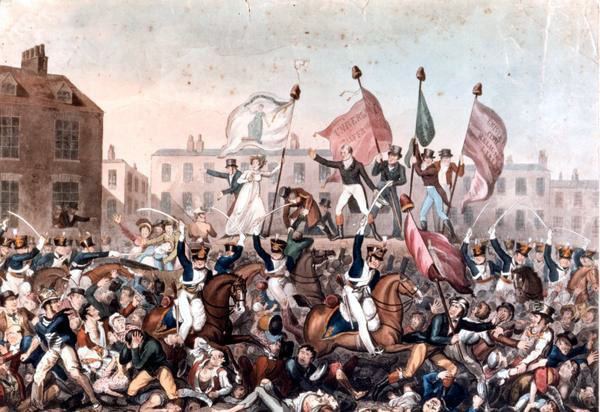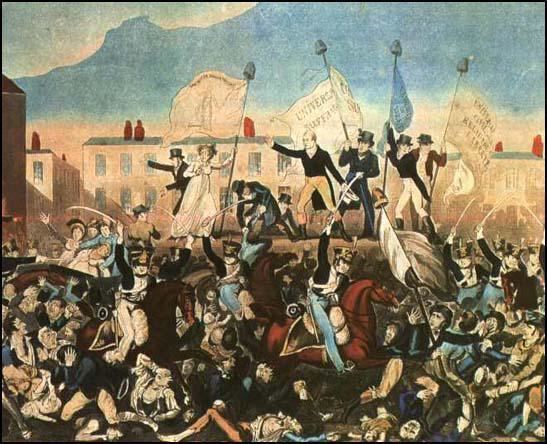Name Mary Fildes | Role Political activist | |
 | ||
Mary Fildes was a political activist and an early Suffragette she was the President of The Manchester Female Reform Society, she is recorded as one of the main protagonists at the infamous Peterloo massacre 1819, she is also the paternal grandmother of Luke Fildes.
Contents

Family
Born Mary Pritchard 1789 in Cork, Ireland, she married William Fildes, Reedmaker, 18 March 1808, Cheshire, England. They had eight children, James Fildes, father of Luke Fildes (1808) Samuel Fildes (1809) George FIldes (1810), Robert Fildes (1815) Sarah (1816). Thomas Paine Fildes (1818) Henry Hunt Fildes (1819) John Cartwright Fildes (1821)
Mary named her children after some of the famous political figures of the day: John Cartwright,Thomas Paine and Henry Hunt
Peterloo Massacre
In 1819 on 16 August, a vast orderly concourse of working men and women assembled on St. Peter's field around what's now St Peters Square on the then outskirts Manchester. Fildes along with other female activists including Elizabeth Gaunt & Sarah Hargreaves were to be placed on the platform or in Hunts carriage holding the flags and banners of the society's represented.
The magistrates fearing unrest and anarchy then gave orders to the Manchester and Salford Yeomanry. A number of the orderly concourse were killed and several hundred were seriously wounded. Mary Fildes was wounded severely while riding on the box sear of Henry Hunt's carriage. In the confusion of the massacre she tumbled off the carriage seat. Eye-witness account 'Mrs. Fildes hanging suspended by a nail on the platform of the carriage had caught her white dress. She was slashed across her exposed body by an officer of the cavalry'.
Reports claimed that the Manchester and Salford Yeomanry attempted to murder her while arresting the leaders of the demonstration. Although badly wounded Mary Fildes survived and continued her campaign for the vote.
The first victim of the massacre was two-year old William Fildes son of Charles & Ann Fildes of Kennedy Street. Ann claims to have been running errands to Cooper Street when she was knocked down by the approaching cavalry and William was thrown from her arms. Although at present no connection is made between Ann, William, and Mary, the closeness of Cooper Street to St Peters Fields indicates that Ann's husband Charles may have been related to Mary's husband William, who was known to have cousins in Manchester at the time. Therefore, Ann may have been in attendance to support her relative at the rally, creating an alternative story as for her reasons for being in the area.
Richard Carlile who was present at the rally describes Mary as a figure like "Joan of Arc" escaping uninjured, his account is given in "THE BATTLE OF THE PRESS" by his daughter Theophila Carlile Campbell.
Political life
In 1833 Mary Fildes & Mrs Broadhurst established the Female Political Union of the Working Classes. When attempting to distribute pamphlets on birth control, Fildes was arrested and charged with the distribution of pornography.
Years went by and Mary Fildes became more of a celebrity.In the 1830s and 1840s Mary Fildes was active in the Chartist movement. She exchanged the tensions of Manchester for the relaxation of Chester and settled down as the proprietress of the "Shrewsbury Arms".
Manchester Female Reform Society
The Manchester Female Reform Society was formed in July 1819
Sir Luke Fildes
It was the first year of the Crimean War that she descended upon her son's home in Liverpool and took her grandson Samuel Luke away- later adopting him. He was privately educated in Chester. Drawing was his main interest. At the age of 14 the notion of his becoming an artist by no means pleased his grandmother. She had envisaged a more substantial life in politics for her grandson and this gave way to a rift between them.
